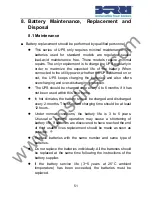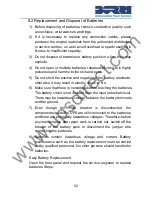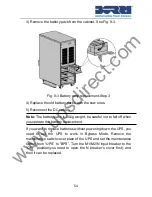
45
10) With the output breakers of each unit switched OFF, switch on the
input breaker. Look at the LCD screen and check for any displayed
fault information.
Once done, check and note each UPS output voltage
independently. If the voltage difference between the unit is less
than 1V then proceed. If not check the wiring.
11) Press the
button of one UPS, each UPS will start to turn on
and all the UPSs will transfer to the INV mode together. Measure
the output voltage of each UPS separately to check if the voltage
difference between them is less than 0.5V. If the difference is more
than 0.5V, the UPS need to be regulated.
12) Press the
button of one UPS, each UPS will turn off and
transfer to the Bypass mode. Once off, switch on the output
breaker of each UPS to parallel.
13) Press the
button of one UPS, each UPS will start to turn on.
After turning on, the UPSs should work in parallel in the Line
mode.
How to join a new UPS to a parallel system:
1)
)
First the parallel system must be installed with a main
maintenance mechanical switch or static switch.
2)
Regulate the output voltage of the new UPS
separately: check if
the output voltage difference between the new UPS and the
parallel system is less than 0.5V.
3)
Ensure the bypass of the parallel system is normal and the bypass
setting is “enable”
. Remove the cover plate of maintenance switch
on the rear panel of each UPS. The UPS system will transfer to
bypass automatically. Set the maintenance switch for each UPS
from “UPS” to “BPS”.
4)
Set the main maintenance switch or static switch from “UPS” to
“BPS”, switch off the main output breaker and the main input
breaker. The UPS will shut down.
www.upsdirect.com












































